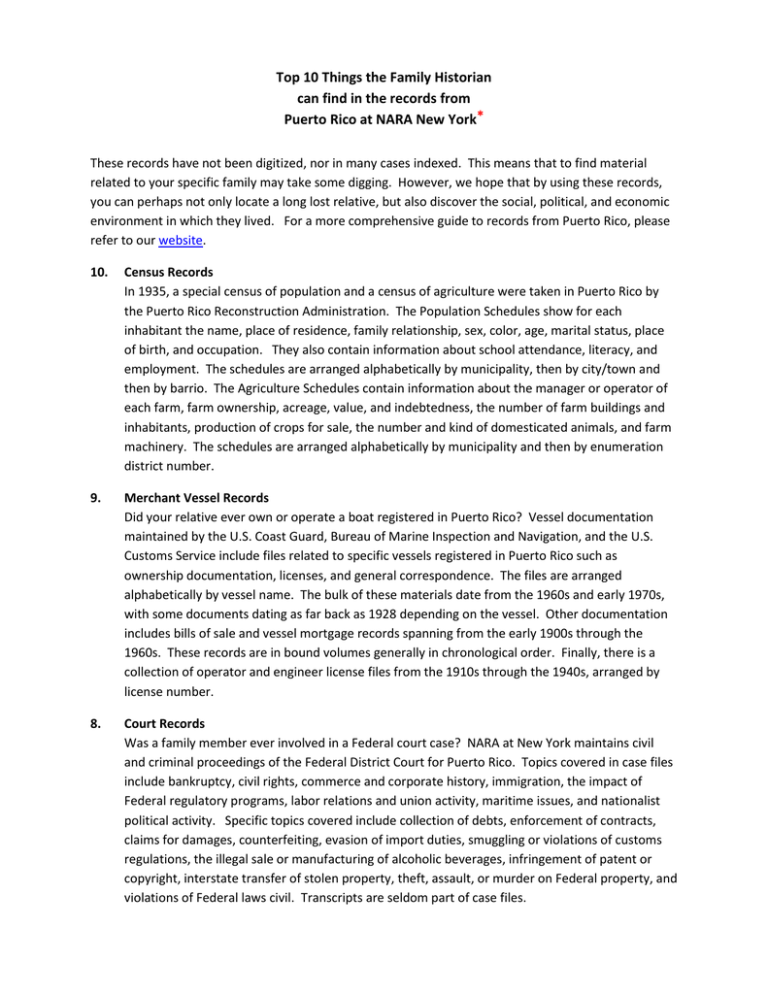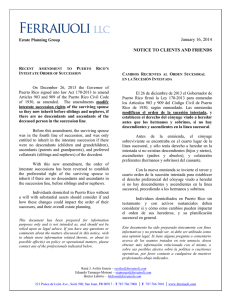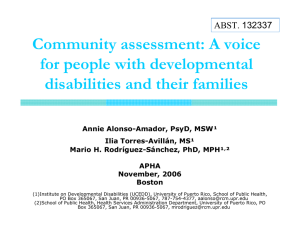Top 10 Things the Family Historian can find in the records from
Anuncio

Top 10 Things the Family Historian can find in the records from Puerto Rico at NARA New York* These records have not been digitized, nor in many cases indexed. This means that to find material related to your specific family may take some digging. However, we hope that by using these records, you can perhaps not only locate a long lost relative, but also discover the social, political, and economic environment in which they lived. For a more comprehensive guide to records from Puerto Rico, please refer to our website. 10. Census Records In 1935, a special census of population and a census of agriculture were taken in Puerto Rico by the Puerto Rico Reconstruction Administration. The Population Schedules show for each inhabitant the name, place of residence, family relationship, sex, color, age, marital status, place of birth, and occupation. They also contain information about school attendance, literacy, and employment. The schedules are arranged alphabetically by municipality, then by city/town and then by barrio. The Agriculture Schedules contain information about the manager or operator of each farm, farm ownership, acreage, value, and indebtedness, the number of farm buildings and inhabitants, production of crops for sale, the number and kind of domesticated animals, and farm machinery. The schedules are arranged alphabetically by municipality and then by enumeration district number. 9. Merchant Vessel Records Did your relative ever own or operate a boat registered in Puerto Rico? Vessel documentation maintained by the U.S. Coast Guard, Bureau of Marine Inspection and Navigation, and the U.S. Customs Service include files related to specific vessels registered in Puerto Rico such as ownership documentation, licenses, and general correspondence. The files are arranged alphabetically by vessel name. The bulk of these materials date from the 1960s and early 1970s, with some documents dating as far back as 1928 depending on the vessel. Other documentation includes bills of sale and vessel mortgage records spanning from the early 1900s through the 1960s. These records are in bound volumes generally in chronological order. Finally, there is a collection of operator and engineer license files from the 1910s through the 1940s, arranged by license number. 8. Court Records Was a family member ever involved in a Federal court case? NARA at New York maintains civil and criminal proceedings of the Federal District Court for Puerto Rico. Topics covered in case files include bankruptcy, civil rights, commerce and corporate history, immigration, the impact of Federal regulatory programs, labor relations and union activity, maritime issues, and nationalist political activity. Specific topics covered include collection of debts, enforcement of contracts, claims for damages, counterfeiting, evasion of import duties, smuggling or violations of customs regulations, the illegal sale or manufacturing of alcoholic beverages, infringement of patent or copyright, interstate transfer of stolen property, theft, assault, or murder on Federal property, and violations of Federal laws civil. Transcripts are seldom part of case files. 7. Agricultural Research Did your family work in agriculture or work on a farm? The Agricultural Experiment Station in Mayaguez began work in Puerto Rico in 1901. The objective of the station was to conduct assessments of the agricultural resources and capabilities of Puerto Rico, especially regarding food production, development of animal industries, dairy farming, and horticulture. The records relate to the operation of the Experiment Station span the years 1901-1935, and are arranged chronologically, but there is little further arrangement. Material is in both English and Spanish. Material covers a broad range of efforts to improve local agriculture detailing experiments involving introduction of improved plant varieties, breeds of animals, methods of agriculture, and farm implements and machinery. Correspondence also includes reports by farmers regarding observations and progress in planting, as well as with farm equipment manufacturers. Specific crops detailed in the records include the coffee and sugarcane industries, as well as assorted foods such as soybeans and corn. 6. Needlework Industry Did any of your relatives work in the needlework industry? The records of the National Recovery Administration contain extensive documentation on the needlework industry between 1933 and 1936. Material includes statistics, questionnaires, and complaints of violations of wage and hour regulations, especially against the Borinquen Embroidery Company. Other records related to the needlework industry can be found in the records of the Hour and Wage Division (see #5). 5. Business, Industry, and Commodity Records The U.S. Food Administration was established to assure the supply, distribution, and conservation of food during World War I by means of voluntary agreements and a licensing system. It appealed to the local population and engaged in community organization and, in so doing, penetrated into almost every part of the country and reached almost every inhabitant. Records are arranged by town and name of firm. The Hour and Wage Division fixed minimum wage rates and maximum work hours for employees in certain industries, such as tobacco production, needlework, sugar production, and other agriculture processes. Inspection and investigation records are filed either by geographic area and company name or by industry. The Office of Price Administration established maximum prices for commodities and maximum rents, rationed scarce essential commodities, and authorized subsidies of some of those commodities. Material is variously arranged by commodity, subject, name of individual, establishment, or town. 4. Puerto Rican Reconstruction Administration (PRRA) As part of the Roosevelt administration’s New Deal initiatives, the PRRA was set up to provide relief and increase employment, with an emphasis on the rehabilitation of Puerto Rico’s agricultural economy. It engaged in such activities as urban and rural housing, demonstration farming, work relief, construction of hydroelectric plants, loans to farmers, and formation of cooperatives. Many of the PRRA records are arranged by municipality and family last name. Also, many records are in Spanish. Records include significant material on land acquisition, rural development projects, and details on housing developments such as La Granja, Mirapalmeras, Juan Morell Campos, Eleanor Roosevelt, and the Puerto Rican Housing Development. Other projects documented include the Lafayette Sugar Corporation, the Cement Plant, and the Arecibo Cannery. Investigation files include the Del Rio Plantation Case, the 500-Acre Case, the case of José Ramón Quiñones, as well as litigation concerning the Puerto Rico Railway Light and Power Company. Farming cooperative records include those concerning the Cooperativa Azucarera Los Caños (Los Caños Sugar Cooperative) and the Cooperativa Lafayette (Lafayette Cooperative). 3. Military Service Was a relative ever posted to the Caribbean during their service in the U.S. military? Records from the San Juan and Culebra Naval Stations, the Tenth Naval District, and to a lesser extent Fort Buchanan and the Rodriguez Army Hospital, document military activity in Puerto Rico. The records, in general, span the years 1899-1913 and 1941-1962. These records are not military service records of individuals, which are held at other National Archives locations. However, the administrative and operational records of various military organizations do provide a surprising level of personal details. Materials cover such topics as operations and maneuvers of specific vessels, general correspondence, hospital information, and various personnel issue such as awards and disciplinary matters. The records also document to a limited extent military interaction with other Federal agencies. There are also issues of “La Garita” the Army Hospital’s news sheet for personnel of Fort Brooke, which provide a unique insight into military life between 1952 and 1962. 2. Land Records Did any of your relatives own land in San Juan or Culebra in the late 19th or early 20th centuries? The records from the San Juan and Culebra Naval Stations contain a wealth of land records related to the development and expansion of these military installations. Records include property value ledgers, rental leases and sales agreements, blueprints, and details of Spanish Royal land grants. Similarly, the records of the Puerto Rican Reconstruction Administration contain extensive land acquisition files, arranged by municipality, related to development projects in the 1930s. U.S. Forest Service records also include land acquisition files related to the expansion of the Caribbean National Forest (El Yunque) in the Luquillo and Toro Negro areas. 1. Citizenship Records The history of Puerto Rican citizenship is complicated at best. The naturalization records from Puerto Rico document the complex relationship between island inhabitants and the Federal government. While many naturalization records concern individuals of other nationalities acquiring U.S. citizenship while resident in Puerto Rico, there are also many records related to native born Puerto Ricans and their quest for American citizenship. Records include petitions for naturalization and declarations of allegiance, repatriation oaths, and naturalization case files. Unique among the naturalization records are various declarations by individuals who wanted to maintain their Spanish nationality. Also, copies of birth certificates are often attached to naturalization records from Puerto Rico. *Note: While the National Archives at New York City maintains responsibility for the records from Puerto Rico, most of these holdings are stored offsite. If you wish to consult any of these records please contact NARA New York staff before your visit so that we may provide you efficient service. You may email us at [email protected] or call us toll-free at 1-866-840-1752.

